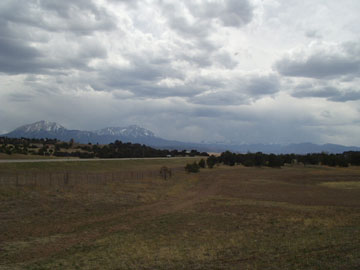
Toward the end of writing Kitty Takes a Holiday (late April 2006), I took a research trip to the locations where the book takes place, just because I could-- all the sites are within a day's drive of Boulder, where I live (We covered almost two thousand miles in about five days).
My Mom, Jo Anne, came along with me. She's an amateur anthropologist, Native American art enthusiast, and has spent quite a bit of time traveling the southwest. I wanted her along so I could pick her brain, and so she could find the good places to eat. (She's a talented traveler.)
A note about how I research my books: I do enough research to understand the subject well enough to feel comfortable writing about it--or at least, to make you think I do. I don't believe in putting ALL my research into a book. So you'll notice there's a lot of information here that isn't in the book. That's because a novel ought to be a story and not a research paper. At least, that's what I think.
It probably behooves you to read the book first, because there are few spoilers. Also, you'll have a better idea of where different places fit into the story.
 |
These are the Spanish Peaks, as viewed on Highway 160 just west of Walsenburg. Right on the border between prairie and mountain, it has the best of both worlds. This was also an incredible cultural crossroads a hundred and fifty years ago. Several Native American tribes, Spanish settlers, and American pioneers all converged here. |
|
Walsenburg sits at the junction of I-25 and U.S. Highway 160. It used to be the center of the region's coal mining. Now, not much goes on there, but something like a million tourists a year pass through it on their way to Colorado's mountain recreation destinations. While it's the largest town for many miles in any direction and the county seat of Huerfano County, it still isn't all that big, with a population of about 4100. Here's the Huerfano County Courthouse, which plays a rather big part toward the end of the novel. It's over a hundred years old. In this part of the world, that's actually pretty old. (I love this saying: Europe and the U.S. will get along better when Europe realizes that a hundred miles isn't very far, and the U.S. realizes that a hundred years isn't very old.) The law enforcement offices, which include the local police and the county sheriff, are behind the courthouse, on the next block. |
 |
Clay, the town where Kitty stays at the start of the book, doesn't exist. Though the books are decidedly set in the real world, I invent major details that play a large part in the story (like nightclubs, tabloid newspapers, raving senators, etc.) that I don't necessarily want associated with real places/people/things. I did base Clay on dozens of small towns found throughout Colorado, particularly in the mountains: old mining camps and ranching towns that managed to hang on, villages that grew up around trading posts, etc.
 |
About twenty miles west of Walsenburg, the two real towns within the shadow of the Spanish Peaks are Cuchara and La Veta. Cuchara used to a be a ski resort--a teeny, tiny ski resort, that closed about 10 years ago-- so it's made up of a lot of vacation homes and cabins, and tends toward the seriously touristy. La Veta is a larger ranching and tourist town. It has a population of around 1000. We stayed in La Veta. Cuchara is about ten miles up the road, further into the mountains. We tried to drive to the summit overlook on one of the peaks, but the road was still snowbound. In fact, it snowed the day after we left. Here I am, about halfway up one of the Spanish Peaks. |
There really is a Wolf Creek Pass.
I'm really glad we made the trip so I could get a better idea of what the landscape of the Four Corners region looks like. (This is the area where Colorado, New Mexico, Arizona, and Utah all come together. There's a place where you can stand on all four states at once.) When I think of the New Mexico desert, I usually picture the land around Santa Fe and Albuquerque, which I'm more familiar with. There's lots of scrub, junipers, pine forests at higher elevations, and during periods of rain lots of green grass. The landscape around Farmington, in western New Mexico, is quite different. Dryer, scrubbier, rockier. The only appreciable vegetation grows along rivers and arroyos. Lots of mining goes on around there.
Like Kitty and Ben, we stayed in Farmington. The town of Shiprock has no hotels. This is another reason it was good we made the trip, because I would have just assumed it did.
|
In retrospect, I didn't paint Farmington in a very good light in the book. In truth, it's the sixth largest city in New Mexico, sprawling and urban in the way of small cities. It has a lovely riverwalk along the Animas River and a historic downtown area with shopping and restaurants. I think it was a function of the novel, which takes place on the margins of just about everything, that Kitty and Ben end up in a not so great part of town. Here's the Animas River, which flows through town and has a set of trails along it. |
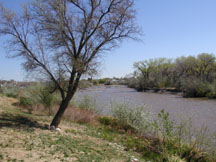 |
Shiprock is part of the Navajo Reservation, which is the largest reservation in the country. It covers a decent chunk of western New Mexico and eastern Arizona. The town of Shiprock is named for a volcanic formation that towers over the desert.
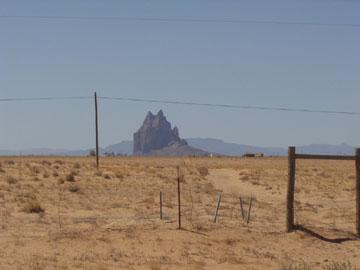
Having had a fairly sheltered, suburban, and predominantly white upbringing, I try to pay special attention to those places and moments where I find that I'm an ethnic minority. The Saturday market at Shiprock was one of those moments. This isn't a market for the tourists. Tourists are certainly welcome, but it's by and for Navajos.
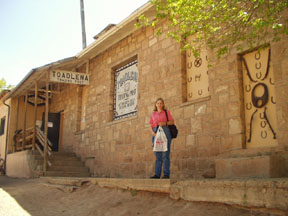 |
Some information collected on a research trip won't make it into a book because it simply isn't relevant. After visiting the market at Shiprock, we took a side trip to Toadlena, so Mom could go to the Toadlena Trading Post and see their rug museum. Toadlena is at the center of the regional style of Navajo rug weaving called Two Grey Hills. It's characterized by natural, earth-tone colors like gray, black, and beige; fine weave upwards of 45 threads per inch; and complex geometric patterns. This is my Mom's favorite style of rug. She has four. While at the post, one of the local weavers was there, spinning wool into yarn while she watched the counter. (Two Grey Hills weavers also spin their own yarn, and often raise the sheep that provide their wool.) She talked to us about learning to weave from her mother and kindly tolerated my stupid questions. (Like how do you keep those complex patterns straight? "You just count the threads," she said.) Yes, Mom did buy a rug. |
While none of what I learned about reservation trading posts and Navajo weaving made it into this novel, it's all filed away for possible future use. That's one of the first rules of writers: everything--every scrap of information, every experience--gets filed away.
 |
Driving back to Shiprock from Toadlena, we encountered a stereotype: sheep on the road. The poor guys had just been shorn and looked kind of pathetic. Notice the landscape in this region: dry dry dry, as far as you can see. |
Here's a bit of research that did make it into the book, though only selectively. Part of this is a function of using a first-person narrative: I can only tell you what Kitty knows, and she isn't going to go looking up a lot of things in the middle of an adventure. The sand painting Louise creates is based on a real traditional pattern: Monster Slayer. (Monster Slayer is one of the great heroes in Navajo mythology, and sand paintings usually depict scenes from mythology.). How incredibly apropos. When I discovered this pattern (from a book I got at the Farmington Museum), I felt like the world had altered itself to fit my storyline. That happens sometimes during the course of researching something, and it's a huge rush. However, I didn't name the pattern in the novel, because like I said, I can only tell you what Kitty knows, and she didn't know what the pattern was. But at least I could describe a realistic-looking sand painting instead of just making something up. I did alter Louise's version of the pattern. Traditionally, the central figure is male. Hers is female. (And I learned how to tell the difference: male figures have round heads, female figures have square heads.)
We spent a few hours just driving around the reservation so I could observe the landscape, see what kind of structures are there, where people live, and then imagining what the land and buildings in the book might be like. That's what a lot of traveling is for me: taking in the look and feel of a place, and figuring out how to get it into prose.
|
Our last stop on the way home: Pagosa Springs, just west of Wolf Creek Pass, for a well-deserved soak in the hot springs. |
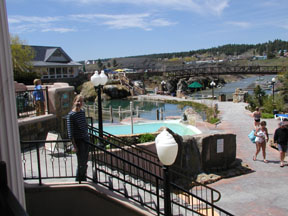 |
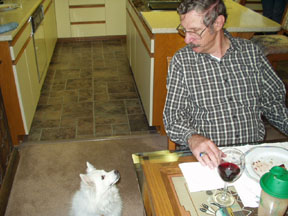
Meanwhile, my dad dogsat my pup Lily. Lily did not get steak, no matter how much she asked for it.
And that's the trip. Thanks for reading!
(Carrie wrote the text. Carrie and Jo Anne took the pictures.)